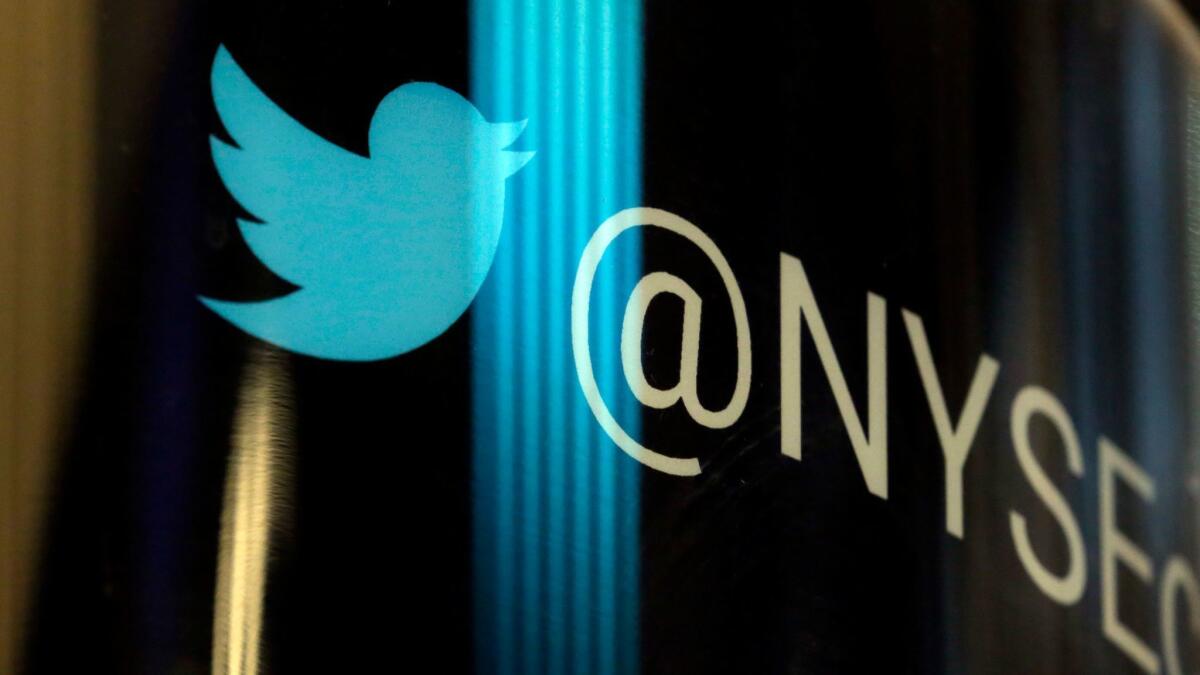Twitter shares dive as even Trump’s tweets fail to provoke solid user growth

- Share via
President Trump wasn’t Twitter’s savior. He was only a distraction.
Despite the social network being the president’s broadcast tool of choice, the San Francisco company failed to add a substantial number of new users during its fourth financial quarter, missed Wall Street’s earnings targets and didn’t spell out a clear strategy for turning things around.
The company’s lagging growth and ongoing financial losses sent its stock tumbling 11.2% on Thursday morning, to $16.60.
Analysts had high hopes for the company going into Thursday’s reporting. While no one expected the social network to leap out of the shadow of its much larger, more profitable competitor Facebook, the president of the United States’ avid use of the platform led some to believe that its most recent quarter may have delivered a spike in public interest and user signups.
“Twitter desperately needs a catalyst for positive user growth,” Clement Thibault, a senior analyst at Investing.com, said Wednesday in a note to investors. “Politics might just do the trick.”
It wound up doing something — just not as much as Wall Street had hoped.
During its fourth fiscal quarter, Twitter’s user growth increased 1% from the previous quarter. The social network added 2 million new monthly active users. During the same period, Facebook added 72 million new monthly active users, representing a 4% increase.
Twitter has 319 million users worldwide. Facebook has 1.86 billion users.
During a call with analysts, Twitter Chief Executive Jack Dorsey said having world leaders such as Trump use the service was a boon to the company, but it’s still too soon to measure whether the president’s use of the platform has had a material effect on the company’s numbers.
“Twitter is buzzing because of Trump, but the important thing to recognize is Trump cannot resolve the underlying problem with the Twitter business model,” said David Giannetto, a social media analyst who authored “Big Social Mobile.” “Everyone who wants to use Twitter is already using Twitter.”
While the president might take to Twitter dozens of times a week to sound off on domestic and international affairs, Giannetto noted that the average American doesn’t even need to be on Twitter to know what he’s tweeting. The president’s most interesting and controversial tweets are already reported on in the news or shared on other social media platforms such as Facebook.
Giannetto described Twitter as a platform that is much more demanding of its users than something like Facebook. Where a person can sign into Facebook once a month to check on what their friends have been up to, Twitter is such a fast-moving platform that a user following a person who tweets as often as Trump would have to be glued to their feed to get the latest tweet as it happens.
“It’s not a platform that creates great engagement among passive users,” Giannetto said. “That’s a weakness of the technology. It only works with somebody who is really interested in scrolling through a long feed. You have to enjoy that. And most people just don’t.”
Twitter has made efforts to address these shortcomings. The company last year added a “Moments” tab to the platform, which serves as a kind of curated highlights reel of popular tweets, organized by category. It also added an “In case you missed it” feature, in which older tweets that a user may not have seen are pushed to the top of the feed.
But these new features have done little to stimulate growth or engagement, which in turn has left advertisers feeling lukewarm at best about spending ad dollars on Twitter.
The company recorded $717.2 million in revenue in its fourth fiscal quarter of 2016, up only 1% from the same period a year earlier. Its losses swelled to $167 million from $90 million in the fourth quarter of 2015.
Per-share earnings of 16 cents in the quarter was 4 cents better than expected, but that was overshadowed by its outlook.
Advertising revenue fell slightly to $638 million in the fourth quarter, and the company said tough competition and Twitter’s push to reevaluate its product portfolio could affect future revenue growth.
The company didn’t offer a revenue forecast for the first quarter of 2017, but it said it expected advertising sales growth to continue to lag behind audience growth this year.
So while it’s unclear what could be Twitter’s savior, analysts at least know what to rule out.
“Despite heavy usage by President Trump,” said Thibault of Investing.com, “[It is] hard to see politics having a revolutionary impact on Twitter in the foreseeable future.”
ALSO
SpaceX faces 4 crucial missions this year
Garlic farm will pay workers $15 an hour, fending off a labor shortage
Viacom’s new CEO pushes turnaround plan for Paramount and MTV: ‘I look under the hood’
UPDATES:
1:55 p.m.: This article was updated to summarize a statement from Twitter Chief Executive Jack Dorsey on a call with analysts and investors.
1:05 p.m.: This article was updated with staff reporting and outside comment from analysts.
This article was originally published at 7:55 a.m.




